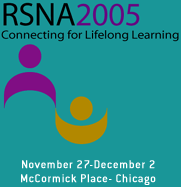
Abstract Archives of the RSNA, 2005
Mark Jonathan Halsted MD, Presenter: Nothing to Disclose
Craig M. Froehle PhD, Abstract Co-Author: Nothing to Disclose
Laurie A. Perry BS, Abstract Co-Author: Nothing to Disclose
Jay A. Moskovitz MS, Abstract Co-Author: Nothing to Disclose
Hong Yang MS, Abstract Co-Author: Nothing to Disclose
Neil David Johnson MD, Abstract Co-Author: Nothing to Disclose
Picture Archiving and Communications Systems (PACS) worklists are often based on time and date of case acquisition rather than on patients' medical acuity. However, the severely acutely ill patient should be seen before the mildly ill patient regardless of when each patient arrived in the department. We developed a tool to help radioloiogists triage patient studies quickly and accurately.
In partnership with a college of business at a major university, we developed, tested, and validated a new electronic triage ranking algorithm, and used it to develop an automated radiology triage system (ARTS) on a web-based platform. We measured operational metrics reflecting workflow efficiency within the radiology department, as well as patient satisfaction, and radiology staff stress and satisfaction, prior to implementation of ARTS and will remeasure after the system is launched.
All measurements have been completed to prepare for launch of the triage system anticipated in midsummer 2005. The system ensures that the most acute case is always interpreted first, and makes study results immediately available to clinicians. The system facilitates communication within and beyond the radiology department, and includes technologist and radiologist "ownership" of cases, the number and acuity of patients in the system at any given time, estimated waiting times for each patient based on expected time of the radiologists' interpretation, and the full text of each preliminary and final intepretation, as well as any addenda. A permanent log is kept of all communications regarding cases, including the time, date, and persons involved in each communication event. Outcomes data documenting the effectiveness of the system will be obtained and analyzed.
This project is ongoing at the time of this abstract submission. The system will be launched this summer and should improve patient care while enhancing satisfaction with radiology department workflow. Ongoing outcomes research will document and quantify these improvements.
Halsted, M,
Froehle, C,
Perry, L,
Moskovitz, J,
Yang, H,
Johnson, N,
Introducing an Automated Radiology Triage System: Improved Workflow, Enhanced Patient Care. Radiological Society of North America 2005 Scientific Assembly and Annual Meeting, November 27 - December 2, 2005 ,Chicago IL.
http://archive.rsna.org/2005/4417344.html

